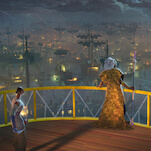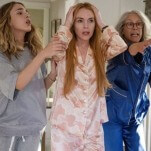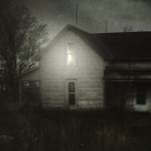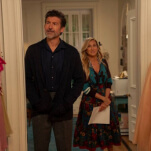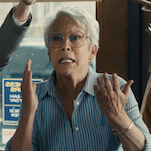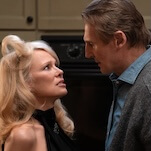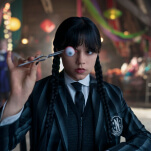The more that promos encroach on the time and space for title sequences, the more valuable the lengthier holdouts become. For every Game Of Thrones, with its luxurious two-minute clockwork map, there’s a three-second title card for The Middle. Jane Campion and Gerard Lee’s miniseries Top Of The Lake has a little more breathing room than the average sitcom—airing as it does in the United States on boutique cable network Sundance—but the opening titles are a master class in efficiently setting the mood.
Top Of The Lake is a slow, haunting crime mystery set in the fictional backwoods New Zealand town of Laketop. Elisabeth Moss’ detective Robin returns to her hometown and gets drawn into the case of a missing, pregnant teenager named Tui (Jacqueline Joe). Meanwhile, Holly Hunter’s GJ opens a sort of women’s commune in a bunch of shipping containers set up on land that Tui’s father Matt, played by Peter Mullan as testosterone incarnate, claims to own. The series’ six hours explore a bitter, entrenched gender war, dredging up all manner of dirty secrets.
Designed by Leonie Savvides, the main titles play like a dollhouse version of Lars von Trier’s Antichrist, as well they might, considering their shared DNA: rage against the patriarchy, foreboding forest creatures, and a color palette washed of all happiness. The opening image is a sight of the titular lake, based on a painting by Séraphine Pick. It’s a calm but sickly image; you can drink it in without immediately succumbing to its creepiness. The sky glows faintly bilious, and the lake reflects a cool, mildewed blue-green receding around dangerously steep mountains that trap all the light in the middle, surrounding the scene in darkness. Pick’s work is the stuff of nightmares, relying heavily on prone bodies and aggressive disfigurement, bringing menace to otherwise familiar situations. At least one of her paintings seems to be a stylistic influence on the miniseries itself: a depiction of three women dancing naked in a field not unlike GJ’s commune. Pick’s contribution to the opening is a natural fit.
From there, the lake oozes forward and begins to drip, and Savvides pans down, down, down. It’s literal, but so is Top Of The Lake, where men fight and women flee. To break free of the rigid gender system in Laketop is as extraordinary as it is dangerous. The painting drips in waves of icy blues and greens that flicker like stop-motion as the cast names appear. Eventually, a spectral something shows up in the distance. It’s a deer head—essentially the Grim Reaper of Laketop: Wherever there’s a hunting trophy, there’s a patriarch with a gun. In one particularly haunting flashback, a mounted deer head serves the superstitious purpose of a ladder, and a character passes underneath to meet certain trauma. The closer the spectral deer gets, the darker the colors grow, until its white outline freezes on the black background, its face staring right at us, then disappears.
That’s when a fetus appears, glowing and growing, until it, too, fades away. An omen for young Tui? Or perhaps a reminder that there are consequences to the gender war that aren’t immediately visible? As the series goes on, it becomes increasingly clear that Campion and Lee are interested in the cycle of how parents inflict their attitudes on the next generation. Finally, down floats a picture of Tui, like a modern Laura Palmer. She’s not necessarily dead yet, but can she survive on that lake on her own?
In 30 seconds, Savvides vividly whets the appetite for Campion and Lee’s mystery. The main titles introduce the missing-person plot, the heightened stakes of pregnancy, the expressionistic setting, the moody colors, the natural symbols, the odd horrors, the buried secrets, and even the free-associating rhythms. Not bad for an art form on the decline.




